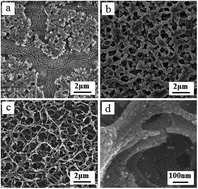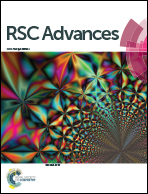Synthesis of a hierarchically meso-macroporous TiO2 film based on UV light-induced in situ polymerization: application to dye-sensitized solar cells†
Abstract
Hierarchically meso-macroporous TiO2 films were prepared via a UV light-induced in situ polymerization of hybrid organic–inorganic films containing propoxylated glyceryltriacrylate monomers and titania precursors. These films were composed of well-connected, net-like frameworks with a large open cavity (0.2–1.5 μm), which were assembled by titania nanocrystals with a size of ∼25 nm and that possessed relatively rich inner crystal mesopores of about 4 nm. The particular net-like frameworks make the film a promising candidate for use as the scattering layer in dye-sensitized solar cells (DSSCs). A bilayer structured photo-electrode, consisting of the net-like framework layer on top of the P25 film, was prepared and exhibited good overall conversion efficiency. Interestingly, the photovoltaic conversion efficiency (η) was improved to 6.95%, much higher than that of P25 single-layer film (6.17%).

- This article is part of the themed collection: Materials for Energy storage

 Please wait while we load your content...
Please wait while we load your content...